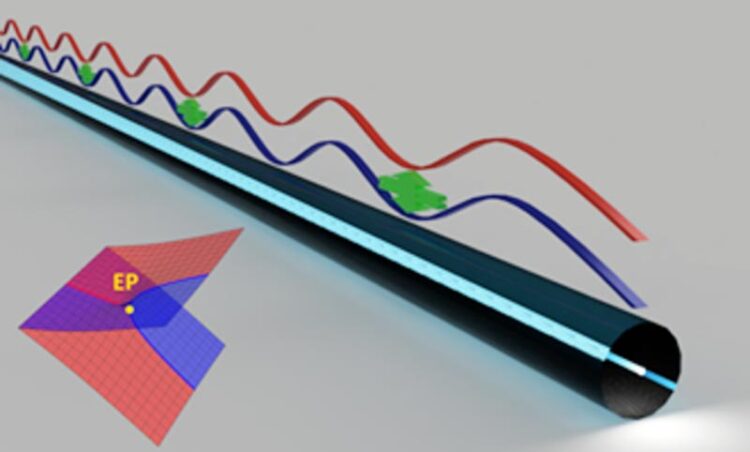First observation of energy-difference conservation in optical domain

Schematic diagram of a fiber-based anti-parity-time system Changes in optical intensity (red and blue lines) propagating along an optical fiber and symmetry-breaking transition at an exceptional point are illustrated.
Credit: POSTECH
When optical gain or loss are precisely controlled using nanophotonics, a new physical event called the non-Hermitian phenomenon can be observed, potentially the next-generation technology of optical signal control and sensing. However, it is difficult to control the optical gain and loss in optical experiments precisely.
Recently, a research team led by Professor Heedeuk Shin of the Department of Physics at POSTECH, in collaboration with a research team led by Professor Jae Woong Yoon of the Department of Physics at Hanyang University, proposed an easy-to-use approach to non-Hermitian optical research and observed the energy-difference conservation in the optical domain for the first time.
The Hermitian-Hamiltonian operator has been used for a long time as a basic operating principle of quantum physics, assuming that there is no energy loss in a closed system. However, all physical systems in an open system have energy loss, which is treated as a simple imperfection and compensated by amplification.
However, the recently emerging field of non-Hermitian physics extends the basic operating principle by giving gain and loss a new role other than simple correction to incomplete systems. Demonstrating physical phenomena different from those of the standard Hermitian-Hamiltonian dynamics is attracting attention as the next generation signal and energy control technology.
Among the non-Hermitian physical systems, anti-parity-time (APT) symmetry systems consisting of balanced gain and loss can induce symmetry-breaking transitions that occur at an exceptional point, energy-difference conservation, and synchronized power oscillations. However, optical energy-difference conservation and synchronized power oscillation have not yet been observed due to the difficulty of balancing perfectly optical gain and loss.
To this, the researchers produced an APT symmetry platform based on nonlinear four-wave-mixing (FWM) using optical fibers widely used in optical communication. Using optical fibers enabled a simple experimental device with an elongated interaction length with little energy loss, which has been difficult to access even in nano-photonics due to the fabrication limitations.
Using the proposed method, the researchers observed synchronized oscillations of optical intensity thanks to the long optical fibers as well as symmetry-breaking transitions at an exceptional point. In addition, using the low loss and nonlinearity of optical fibers, the energy-difference conservation – a unique behavior of the APT symmetry systems – was observed for the first time in the optical domain.
“This study provides an efficient experimental framework for research on non-Hermitian physics,” explained Professor Heedeuk Shin of POSTECH. “It will contribute to higher-level non-Hermitian research and become an important stepping stone for interdisciplinary research including materials development and quantum information science.”
The findings from this study were published in Physical Review Letters (published by the American Physical Society) on August 17, 2021.
Journal: Physical Review Letters
DOI: 10.1103/PhysRevLett.127.083601
Article Title: Optical Energy-Difference Conservation in a Synthetic Anti-PT-Symmetric System
Article Publication Date: 17-Aug-2021
Media Contact
Jinyoung Huh
Pohang University of Science & Technology (POSTECH)
jyhuh@postech.ac.kr
Office: 82-54-279-2415
Media Contact
All latest news from the category: Physics and Astronomy
This area deals with the fundamental laws and building blocks of nature and how they interact, the properties and the behavior of matter, and research into space and time and their structures.
innovations-report provides in-depth reports and articles on subjects such as astrophysics, laser technologies, nuclear, quantum, particle and solid-state physics, nanotechnologies, planetary research and findings (Mars, Venus) and developments related to the Hubble Telescope.
Newest articles

Innovative 3D printed scaffolds offer new hope for bone healing
Researchers at the Institute for Bioengineering of Catalonia have developed novel 3D printed PLA-CaP scaffolds that promote blood vessel formation, ensuring better healing and regeneration of bone tissue. Bone is…

The surprising role of gut infection in Alzheimer’s disease
ASU- and Banner Alzheimer’s Institute-led study implicates link between a common virus and the disease, which travels from the gut to the brain and may be a target for antiviral…

Molecular gardening: New enzymes discovered for protein modification pruning
How deubiquitinases USP53 and USP54 cleave long polyubiquitin chains and how the former is linked to liver disease in children. Deubiquitinases (DUBs) are enzymes used by cells to trim protein…


